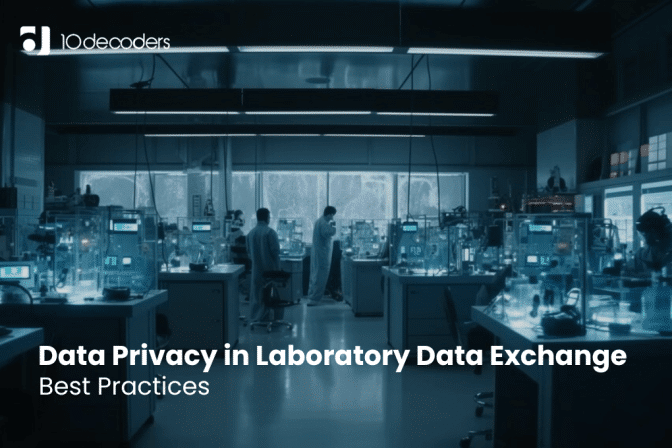Data Privacy in Laboratory Data Exchange: Best Practices
The scientific landscape thrives on collaboration. Sharing data between laboratories fuels groundbreaking research, accelerates discoveries, and paves the way for innovative solutions. However, in today’s digital age, data privacy and compliance have become paramount concerns. This blog takes a deep dive into the intricacies of data privacy in laboratory data exchange, offering best practices to ensure secure and compliant collaboration.
1. Understanding the Data Landscape
Before diving into practices, it’s crucial to map the data landscape. Categorise the data you exchange
- Personal data: Identifiable information like names, addresses, and medical records. Requires robust protection under regulations like GDPR and HIPAA.
- Non-personal data: Anonymized data sets or aggregated results. Still subject to data protection laws depending on jurisdiction.
- Sensitive data: Intellectual property, trade secrets, or commercially valuable information. Requires contractual agreements and access controls.
The benefits of sharing laboratory data are undeniable. It enables researchers to
- Replicate and validate findings: Open data fosters transparency and allows others to verify the accuracy and reproducibility of research.
- Accelerate research: Sharing datasets facilitates meta-analyses, leading to novel insights and faster breakthroughs.
- Promote collaboration: Open data platforms connect researchers across borders and disciplines, fostering innovation and cross-pollination of ideas.
2. Implementing Data Minimization
Collect and exchange only the data essential for the research project. Avoid unnecessary data collection, as it increases the attack surface and complicates compliance. Prioritise anonymization or pseudonymization where possible, minimising the risk of identifying individuals.
3. Building a Secure Infrastructure
Invest in robust security measures to protect your data from unauthorised access, breaches, and manipulation. Implement
- Access control: Granular permissions to restrict access to data based on roles and need-to-know principles.
- Encryption: Encrypt data at rest and in transit, rendering it unusable to unauthorised parties.
- Data backup and recovery: Regular backups and robust recovery plans ensure data availability even after incidents.
- Vulnerability management: Regularly scan systems for vulnerabilities and patch them promptly.
4. Data Transfer Agreements and Contracts
Formalise data exchange agreements with collaborators. These agreements should clearly define
- Purpose and scope of data exchange: Specify the research project, data types, and permitted uses.
- Data ownership and rights: Define who owns the data, who has access, and usage limitations.
- Data security measures: Outline the security protocols both parties must adhere to.
- Confidentiality and non-disclosure: Protect sensitive information from unauthorised disclosure.
- Dispute resolution: Establish procedures for resolving any conflicts arising from data exchange.
5. Training and Awareness
Educate researchers and lab personnel on data privacy regulations, best practices, and security protocols. Regular training sessions can
- Raise awareness of data privacy risks and compliance obligations.
- Equip personnel with skills to handle data securely and ethically.
- Foster a culture of data security within the laboratory.
6. Monitoring and Auditing
Continuously monitor your data exchange practices and infrastructure for potential vulnerabilities or breaches. Implement
- Activity logs: Track user access and data transfers for audit purposes.
- Intrusion detection and prevention systems: Proactively detect and prevent unauthorised access attempts.
- Regular security audits: Conduct periodic assessments to identify and address security gaps.
7. Utilising Trusted Third-Party Platforms
Consider utilising secure data repositories or platforms specifically designed for scientific data exchange. These platforms offer
- Controlled access: Granular access controls and permission management.
- Data encryption and security: Robust security measures to protect data at rest and in transit.
- Compliance support: Assistance with navigating data privacy regulations and compliance requirements.
8. Staying Updated on Regulations
Data privacy regulations are constantly evolving. Stay informed about relevant regulations in your jurisdiction and those of your collaborators. Regularly review and update your data privacy practices to ensure compliance.
Conclusion
Navigating data privacy in laboratory data exchange requires a multi-faceted approach. By implementing these best practices, laboratories can foster a culture of data security, protect sensitive information, and ensure compliance with relevant regulations. Remember, data privacy is not a one-time effort; it’s an ongoing process that requires continuous vigilance and adaptation. By prioritising data security and building trust with collaborators, laboratories can unleash the full potential of scientific collaboration while safeguarding the privacy of individuals and research data.
This blog has provided a roadmap for navigating data privacy in laboratory data exchange. While the specific implementation details may vary depending on your laboratory’s specific needs and resources, the core principles of data minimization, secure infrastructure, and compliance-driven practices remain essential for responsible and trustworthy data sharing. Let’s work together to create a data-driven scientific future that prioritises both innovation and individual privacy.



